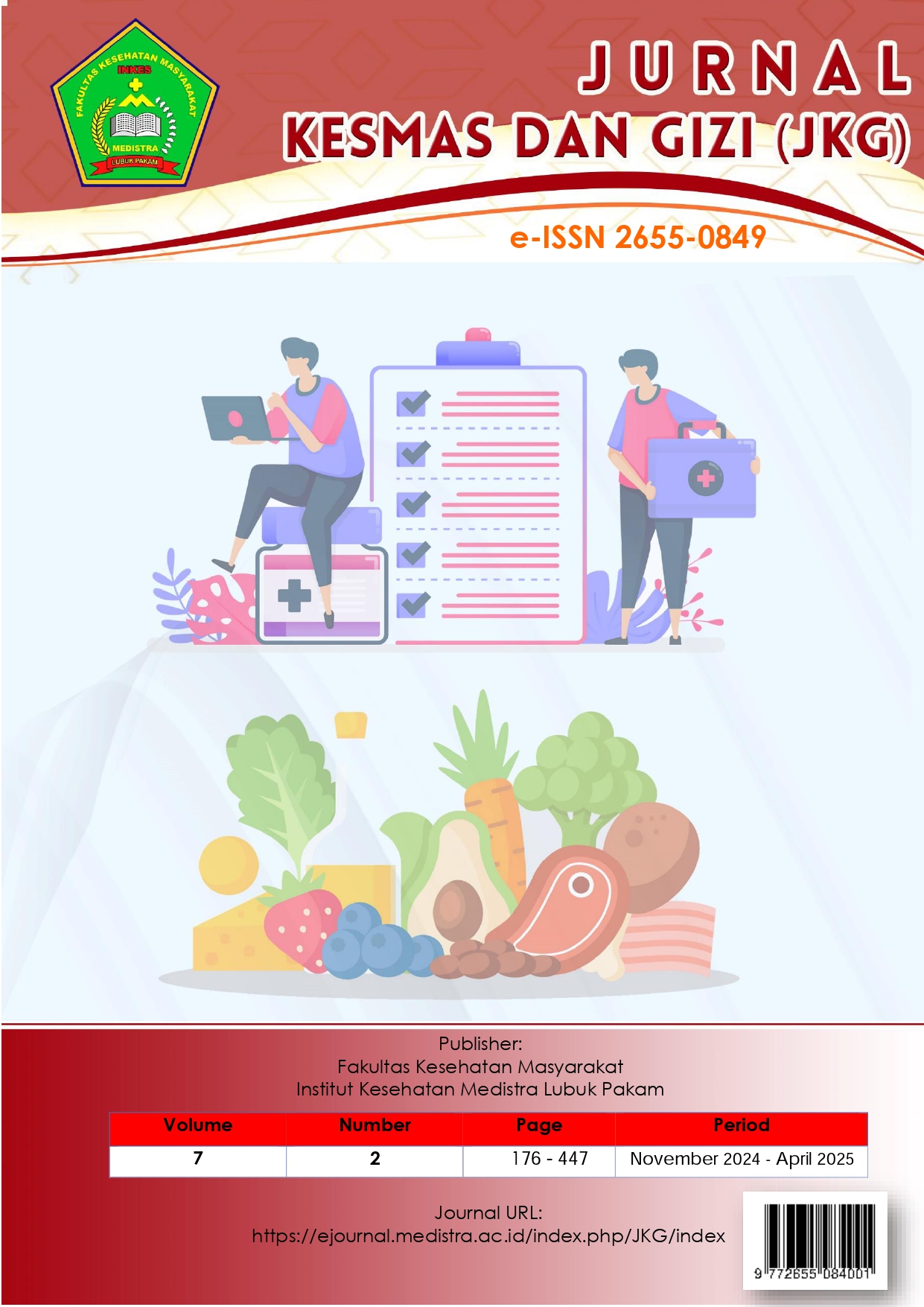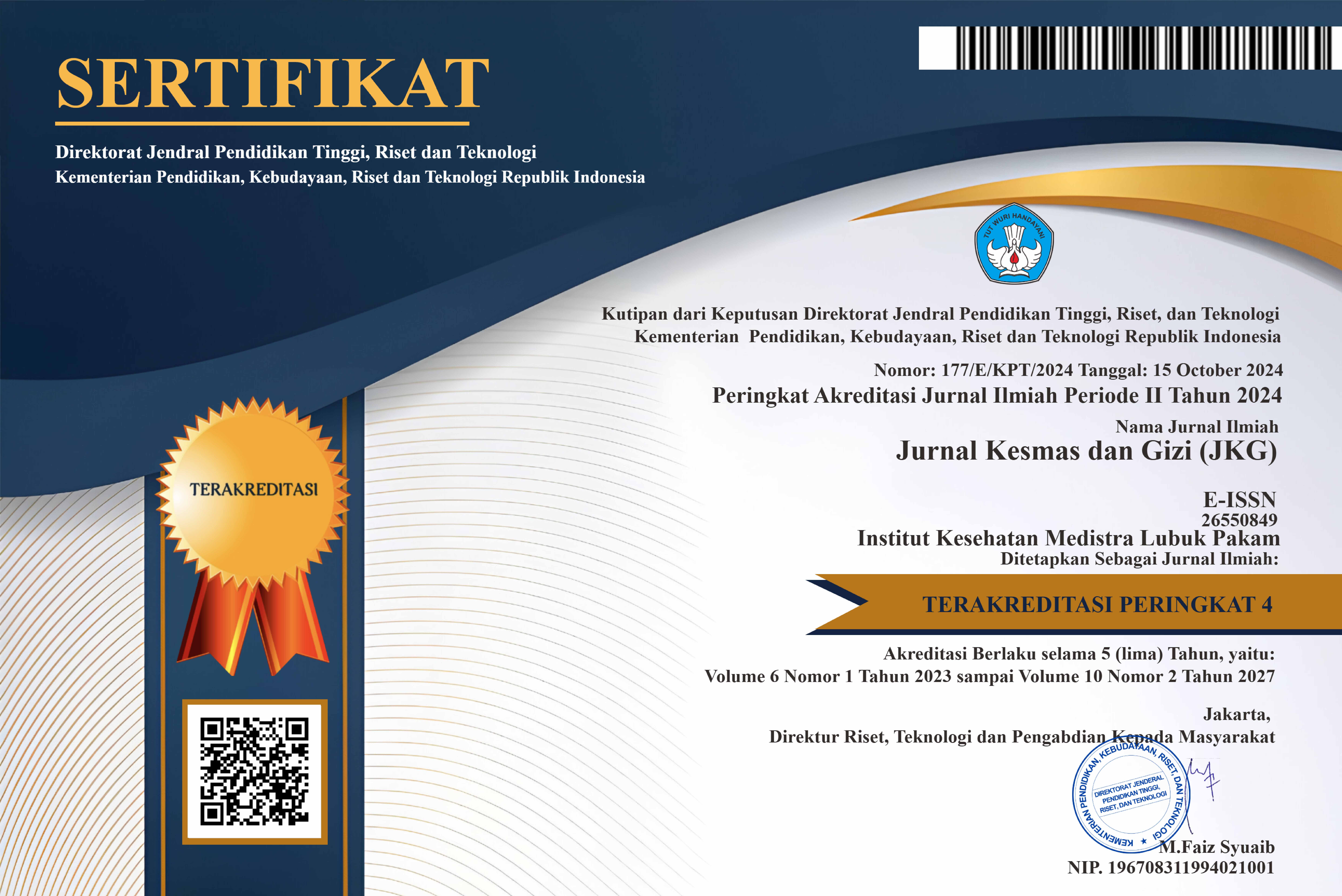Relationship Between Implementation of Risk Analysis (Risk Assessment) and Reducing Patient Safety Incidents in Inpatient Installations)
DOI:
https://doi.org/10.35451/bgfchd78Keywords:
risk assessment, patient safety, ; inpatient unit, incident reporting, hospital risk managementAbstract
Patient safety is a crucial indicator of healthcare service quality. In Indonesia, inpatient units are among the most vulnerable areas for patient safety incidents due to the complexity of medical procedures and prolonged patient contact. Risk assessment plays a key role in minimizing adverse events by identifying potential hazards, evaluating risk levels, and implementing preventive measures. This study aims to analyze the relationship between the implementation of risk assessment and the reduction of patient safety incidents in the inpatient department of RSU Sembiring Delitua. A cross-sectional quantitative study was conducted in April–June 2025, involving 50 healthcare workers selected through total sampling. Data were collected using validated questionnaires and secondary data from the hospital's Patient Safety Committee. Univariate and bivariate analyses (Chi-Square test) were used. The results showed that 76% of respondents routinely identified risks, 70% actively reported incidents, and 66% followed up on assessments. Incident data from 2023 to 2024 showed a 43.75% reduction in total incidents, particularly medication errors and patient falls. The Chi-Square test revealed a significant relationship between risk assessment and the incidence of patient safety events (p = 0.018). The study concludes that effective risk assessment significantly contributes to reducing patient safety incidents. This finding emphasizes the need for continuous risk management practices, strong institutional support, and the cultivation of a safety culture across all levels of hospital services.
Downloads
References
World Health Organization (WHO). Patient safety. Geneva: World Health Organization; 2021. Available from: https://www.who.int/news-room/fact-sheets/detail/patient-safety
Komite Nasional Keselamatan Pasien (KNKP). Laporan tahunan keselamatan pasien. Jakarta: Komite Nasional Keselamatan Pasien; 2020.
Vincent C. Patient safety. 2nd ed. Oxford: Wiley-Blackwell; 2010.
Alam S, Hossain M, Rahman M, et al. Impact of risk assessment on patient safety in hospitals: A two-year study. J Health Risk Manag. 2018;9(3):135-142. doi:10.1016/j.jhrm.2018.02.002
Ayub A, Ahmad M, Rauf S, et al. Risk management and patient safety in hospital settings. Int J Health Sci. 2020;14(5):98-105. doi:10.1016/j.ijhs.2020.05.003
Dewa R, Hasan M, Sulaiman F. Risk assessment in healthcare: A proactive approach to patient safety. Risk Manag Health Policy. 2021;14:1-10. doi:10.2147/RMHP.S288045
Singla P, Sharma P, Rana S, et al. Integrating risk assessment into healthcare quality cycles to improve patient safety. Qual Manag Health Care. 2019;28(3):154-160. doi:10.1097/QMH.0000000000000226
Hughes RG. Patient Safety and Quality: An Evidence-Based Handbook for Nurses. Agency for Healthcare Research and Quality (US); 2008.
Carayon P, Wood KE. Patient safety: The role of human factors and systems engineering. Stud Health Technol Inform. 2010;153:23–46.
Vincent C. Patient Safety. 2nd ed. Oxford: Wiley-Blackwell; 2010.
Sammer CE, Lykens K, Singh KP, Mains DA, Lackan NA. What is patient safety culture? A review of the literature. J Nurs Scholarsh. 2010;42(2):156–65.
Kementerian Kesehatan RI. Laporan Nasional Insiden Keselamatan Pasien Indonesia. Jakarta: Direktorat Mutu Pelayanan Kesehatan; 2019.
WHO. Patient safety: Global action on patient safety. Geneva: World Health Organization; 2021.
Sari AB, Sheldon TA, Cracknell A, Turnbull A. Sensitivity of routine system for reporting patient safety incidents in an NHS hospital: Retrospective patient case note review. BMJ. 2007;334(7584):79.
Wachter RM. Understanding Patient Safety. 3rd ed. New York: McGraw-Hill Education; 2017.
Reason J. Human error: Models and management. BMJ. 2000;320(7237):768–70.
Pronovost PJ, Cleeman JI, Wright D, Srinivasan A. Fifteen years after To Err Is Human: A success story to learn from. BMJ Qual Saf. 2015;24(1):50–3.
Flott K, Graham C, Darzi A, Mayer E. Can we use patient-reported feedback to drive change? The challenges of using patient-reported feedback and how they might be addressed. BMJ Qual Saf. 2017;26(6):502–7.
Weaver SJ, Lubomksi LH, Wilson RF, Pfoh ER, Martinez KA, Dy SM. Promoting a culture of safety as a patient safety strategy: A systematic review. Ann Intern Med. 2013;158(5 Pt 2):369–74.
Leape LL. Reporting of adverse events. N Engl J Med. 2002;347(20):1633–8.
Downloads
Published
Issue
Section
License
Copyright (c) 2025 Ahmad Hafizullah Ritonga

This work is licensed under a Creative Commons Attribution 4.0 International License.
Copyright in each article is the property of the Author.


























